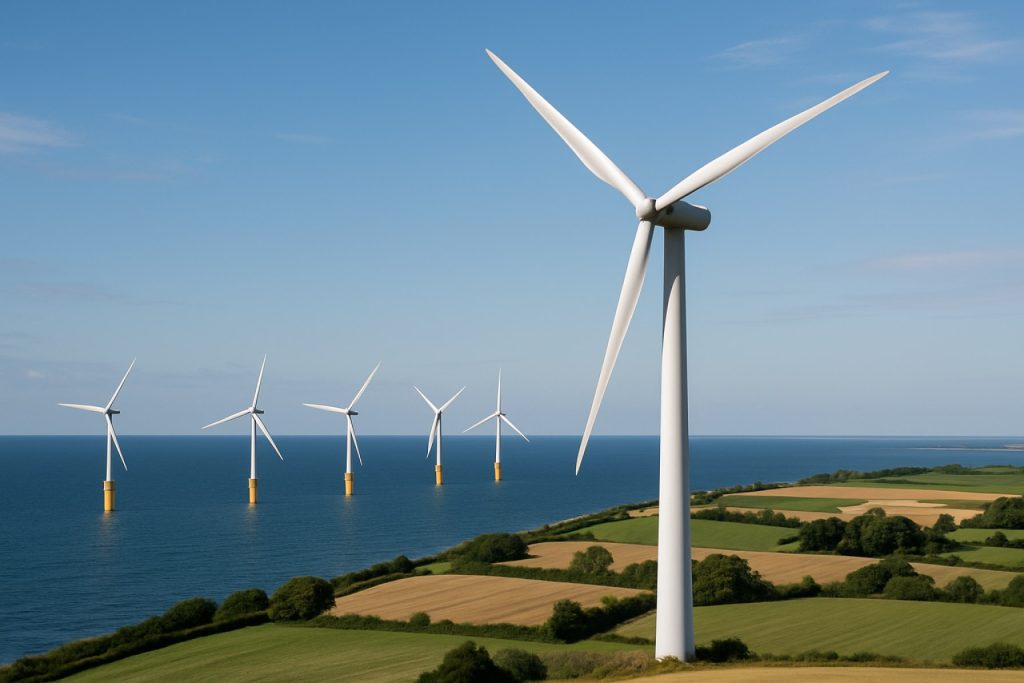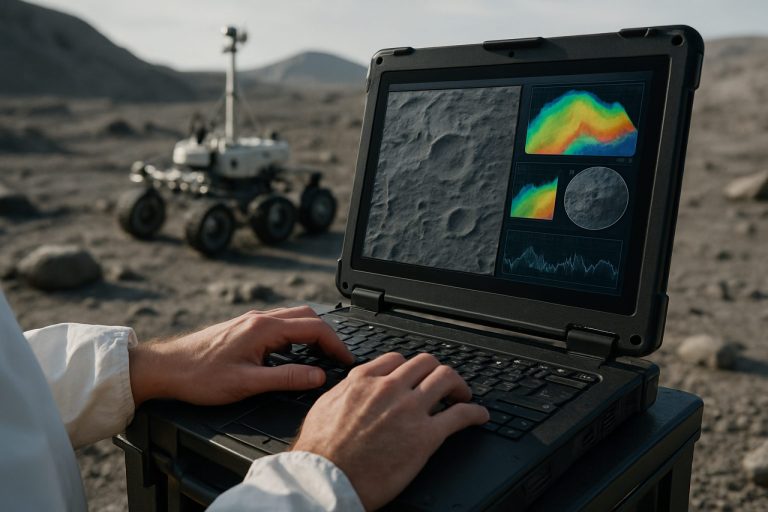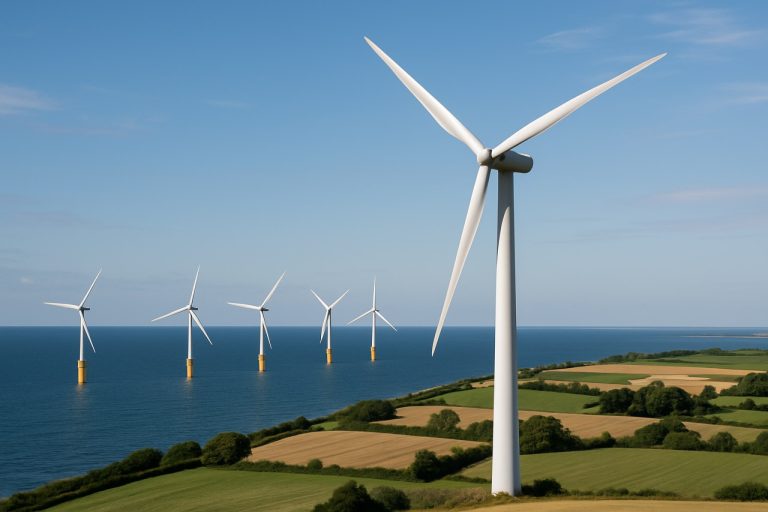
Offshore & Onshore Wind Energy Technology in 2025: Unleashing Next-Gen Turbines, Digitalization, and Global Expansion. Discover How Innovation and Policy Are Accelerating a Projected 60% Market Surge by 2030.
- Executive Summary: 2025–2030 Wind Energy Market Outlook
- Global Market Size, Growth Drivers, and 60% Expansion Forecast
- Offshore Wind: Floating Platforms, Deepwater Advances, and Leading Projects
- Onshore Wind: Turbine Scaling, Grid Integration, and Repowering Trends
- Digitalization & AI: Predictive Maintenance, Remote Monitoring, and Smart Grids
- Supply Chain Innovations: Materials, Logistics, and Local Content Strategies
- Policy, Regulation, and Incentives: Global and Regional Perspectives
- Key Players and Competitive Landscape (e.g., siemensgamesa.com, vestas.com, ge.com/renewableenergy)
- Sustainability, Circularity, and End-of-Life Solutions
- Future Outlook: Technology Roadmaps, Investment Hotspots, and Strategic Recommendations
- Sources & References
Executive Summary: 2025–2030 Wind Energy Market Outlook
The period from 2025 to 2030 is poised to be transformative for both offshore and onshore wind energy technologies, driven by ambitious decarbonization targets, rapid technological advancements, and expanding global investment. As of 2025, the global installed wind power capacity is expected to surpass 1,000 GW, with a growing share attributed to offshore installations. The industry is witnessing a shift toward larger, more efficient turbines, digitalization, and integrated energy solutions, all of which are accelerating cost reductions and grid integration.
Onshore wind remains the backbone of global wind deployment, with leading manufacturers such as Siemens Gamesa Renewable Energy, Vestas Wind Systems, and GE Vernova continuing to innovate in turbine design, predictive maintenance, and modular construction. Turbine ratings are steadily increasing, with 6–7 MW models becoming standard for new projects, enabling higher capacity factors and reduced levelized cost of energy (LCOE). Digital platforms and advanced analytics are being widely adopted to optimize asset performance and extend operational lifetimes.
Offshore wind is experiencing even more rapid technological evolution. Turbine sizes are scaling up dramatically, with 15 MW+ models entering commercial deployment by 2025, led by companies such as Siemens Gamesa Renewable Energy and GE Vernova. Floating offshore wind, once a niche technology, is moving toward commercialization, opening vast new areas for development in deeper waters. Equinor and Ørsted are among the pioneers advancing floating wind projects, leveraging proprietary platform designs and integrated digital monitoring.
Grid integration and hybridization are also key trends. Wind farms are increasingly being paired with battery storage and green hydrogen production, enhancing grid stability and enabling new revenue streams. Major utilities and developers, including RWE and EDP Renewables, are investing in hybrid projects that combine wind, solar, and storage at scale.
Looking ahead to 2030, the global wind market is expected to see annual installations consistently above 100 GW, with offshore wind accounting for a growing proportion. Policy support, supply chain expansion, and continued innovation will be critical to meeting these targets. The sector’s outlook remains robust, with wind energy set to play a central role in the global transition to net zero.
Global Market Size, Growth Drivers, and 60% Expansion Forecast
The global wind energy sector—encompassing both offshore and onshore technologies—is poised for robust expansion in 2025 and the following years, driven by ambitious decarbonization targets, technological advancements, and supportive policy frameworks. The combined market size for wind energy installations is expected to surpass 1,000 GW of cumulative capacity worldwide by the end of 2025, with onshore wind accounting for the majority but offshore wind experiencing the fastest growth rate. According to industry data, the global wind market is projected to expand by approximately 60% in total installed capacity between 2023 and 2030, with annual additions consistently exceeding 100 GW from 2025 onward.
Key growth drivers include government commitments to net-zero emissions, rising corporate demand for renewable power purchase agreements, and the declining levelized cost of energy (LCOE) for both onshore and offshore wind. Technological innovation—such as larger, more efficient turbines, digitalization, and advanced materials—continues to reduce costs and improve project economics. Leading turbine manufacturers like Siemens Gamesa Renewable Energy, GE Vernova, and Vestas Wind Systems are at the forefront of these advancements, introducing next-generation turbines with capacities exceeding 15 MW for offshore and 6 MW for onshore applications.
Offshore wind, in particular, is set for exponential growth, with major markets in Europe, China, and the United States accelerating project pipelines. The European Union aims to reach at least 60 GW of offshore wind by 2030, up from around 16 GW in 2021, while China has already become the world’s largest offshore wind market, adding over 10 GW in a single year and targeting further expansion. The United States, supported by federal and state-level initiatives, is advancing large-scale projects along the Atlantic coast, with a goal of deploying 30 GW of offshore wind by 2030, as outlined by the U.S. Department of Energy.
Onshore wind remains the backbone of global wind capacity, with continued growth in established markets such as the United States, Germany, and India, as well as emerging markets in Latin America and Africa. The sector’s outlook is further bolstered by grid modernization efforts and the integration of energy storage solutions, which enhance the reliability and flexibility of wind power.
Overall, the wind energy industry’s 60% expansion forecast reflects a convergence of policy ambition, technological progress, and market demand, positioning both offshore and onshore wind as central pillars of the global energy transition through 2025 and beyond.
Offshore Wind: Floating Platforms, Deepwater Advances, and Leading Projects
Offshore wind energy technology is undergoing rapid transformation, with floating platforms and deepwater solutions at the forefront of innovation in 2025. Traditional fixed-bottom turbines have dominated shallow waters, but the industry is now pushing into deeper seas to unlock vast wind resources previously inaccessible. Floating wind platforms, which can be anchored in waters exceeding 60 meters in depth, are enabling this expansion and are expected to play a pivotal role in the global energy transition over the next few years.
Several leading companies are driving these advances. Equinor, a Norwegian energy major, has been a pioneer in floating wind technology, notably with its Hywind Scotland project—the world’s first commercial floating wind farm. Building on this, Equinor is developing larger projects such as Hywind Tampen, which is set to supply renewable power to offshore oil and gas platforms, demonstrating the integration of wind with other sectors. Principle Power is another key player, providing its WindFloat platform technology to multiple demonstration and pre-commercial projects worldwide, including the WindFloat Atlantic project off Portugal.
In 2025, the global installed capacity of floating offshore wind is expected to surpass 2000 MW, with significant growth projected through the decade as more commercial-scale projects come online. The United Kingdom, France, Norway, South Korea, and Japan are among the countries advancing large-scale floating wind initiatives, supported by government targets and auction schemes. For example, the UK’s ScotWind leasing round has awarded seabed rights for several floating wind projects, aiming to deliver gigawatt-scale capacity by the late 2020s (The Crown Estate).
Technological advances are also being made in turbine size and foundation design. Leading turbine manufacturers such as Siemens Gamesa Renewable Energy and Vestas are developing next-generation offshore turbines with capacities exceeding 15 MW, specifically engineered for floating and deepwater applications. These larger turbines, combined with innovative mooring and anchoring systems, are expected to reduce the levelized cost of energy (LCOE) and accelerate commercial deployment.
Looking ahead, the outlook for floating offshore wind is robust. Industry bodies such as Global Wind Energy Council forecast exponential growth, with floating wind poised to become a mainstream renewable energy source by 2030. As technology matures and supply chains scale up, floating platforms will enable offshore wind to contribute significantly to decarbonization goals and energy security worldwide.
Onshore Wind: Turbine Scaling, Grid Integration, and Repowering Trends
Onshore wind energy technology is undergoing rapid transformation in 2025, driven by the twin imperatives of scaling up turbine capacity and integrating variable renewables into increasingly complex power grids. The global onshore wind market is characterized by the deployment of ever-larger turbines, with leading manufacturers such as Siemens Gamesa Renewable Energy, GE Vernova, and Nordex Group introducing models in the 5–7 MW class for land-based projects. These turbines feature rotor diameters exceeding 170 meters, enabling higher energy yields per unit and making wind power viable in lower-wind regions. For example, Siemens Gamesa Renewable Energy has launched its 5.X platform, which is being deployed across Europe and Latin America, offering flexible tower heights and advanced digital controls for site optimization.
Grid integration remains a central challenge as wind penetration increases. Modern onshore turbines are now equipped with advanced power electronics and grid-forming inverters, allowing for more stable operation and improved fault ride-through capabilities. Companies like GE Vernova are investing in digital solutions and hybrid systems that combine wind, storage, and grid services to enhance reliability and flexibility. In 2025, several European countries are piloting “wind+storage” projects, leveraging battery systems to smooth output and provide ancillary services, a trend expected to accelerate as grid codes evolve to accommodate higher shares of renewables.
Repowering—replacing older turbines with modern, higher-capacity models—is gaining momentum, particularly in mature markets such as Germany, Denmark, and the United States. The technical and economic benefits are significant: new turbines can deliver up to three times the output of legacy machines on the same footprint, while reducing maintenance costs and environmental impact. Nordex Group and Siemens Gamesa Renewable Energy are actively involved in repowering projects, offering tailored solutions for site-specific constraints and regulatory requirements. In the U.S., the Department of Energy projects that repowering could account for up to 20% of annual onshore wind additions by the late 2020s.
Looking ahead, the onshore wind sector is expected to see continued innovation in blade materials, digital monitoring, and predictive maintenance, further driving down levelized costs of energy (LCOE). As grid operators and policymakers push for higher renewable shares, the integration of wind with storage and demand response will be critical to ensuring system stability and maximizing the value of wind assets.
Digitalization & AI: Predictive Maintenance, Remote Monitoring, and Smart Grids
Digitalization and artificial intelligence (AI) are rapidly transforming offshore and onshore wind energy technology, with 2025 marking a pivotal year for the integration of predictive maintenance, remote monitoring, and smart grid solutions. As wind farms scale up in size and complexity, operators are increasingly leveraging digital tools to optimize performance, reduce costs, and enhance reliability.
Predictive maintenance, powered by AI and machine learning, is becoming standard practice across leading wind turbine manufacturers and operators. By analyzing real-time data from sensors embedded in turbines, these systems can forecast component failures before they occur, minimizing unplanned downtime and extending asset lifespans. Siemens Gamesa Renewable Energy, a global leader in wind turbine manufacturing, has expanded its digital service portfolio to include advanced diagnostics and predictive analytics, enabling proactive maintenance scheduling and reducing operational expenditures. Similarly, GE Vernova (formerly GE Renewable Energy) offers its Digital Wind Farm platform, which utilizes AI-driven insights to optimize turbine performance and maintenance cycles.
Remote monitoring is another area experiencing significant advancements. Operators can now oversee entire fleets of offshore and onshore turbines from centralized control centers, using high-resolution data streams to detect anomalies and coordinate rapid response teams. Vestas Wind Systems, the world’s largest wind turbine manufacturer, has invested heavily in cloud-based monitoring solutions, allowing for real-time performance tracking and remote troubleshooting. This capability is particularly crucial for offshore wind farms, where access is often limited by weather and logistical constraints.
Smart grid integration is also accelerating, as grid operators seek to accommodate the variable output of wind energy while maintaining stability and reliability. Digital platforms are enabling more dynamic interaction between wind farms and the grid, supporting features such as demand response, frequency regulation, and energy storage integration. ABB, a major supplier of grid infrastructure, is deploying digital substations and advanced grid management software to facilitate seamless integration of renewable assets. Meanwhile, Siemens Energy is advancing grid edge technologies that enable real-time balancing of supply and demand.
Looking ahead to the next few years, the convergence of digitalization, AI, and advanced analytics is expected to further drive efficiency gains and cost reductions in wind energy. As more operators adopt these technologies, the industry will benefit from improved asset reliability, lower maintenance costs, and enhanced grid flexibility—key factors in accelerating the global transition to renewable energy.
Supply Chain Innovations: Materials, Logistics, and Local Content Strategies
The wind energy sector is undergoing rapid transformation in its supply chain strategies, driven by the dual imperatives of scaling up deployment and meeting increasingly stringent local content requirements. In 2025 and the coming years, both offshore and onshore wind projects are focusing on innovations in materials, logistics, and localization to address cost, sustainability, and geopolitical challenges.
A key trend is the adoption of advanced materials to improve turbine performance and reduce lifecycle costs. Major manufacturers such as Siemens Gamesa Renewable Energy and GE Vernova are investing in lighter, stronger composite materials for blades, including carbon fiber and recyclable thermoplastics. These innovations not only enable larger rotor diameters—critical for offshore wind—but also facilitate easier transportation and recycling at end-of-life. For example, Vestas Wind Systems has announced progress on fully recyclable blade technology, aiming for commercial deployment in the near future.
Logistics remains a major bottleneck, especially for offshore wind, where components such as nacelles and blades are growing in size and weight. To address this, companies are localizing manufacturing and pre-assembly facilities near project sites. Siemens Gamesa Renewable Energy and GE Vernova have both established or expanded blade and nacelle factories in key markets such as the United States and the United Kingdom. This reduces transport costs, mitigates supply chain risks, and supports local economies. Additionally, the use of digital supply chain management and real-time tracking is becoming standard, improving efficiency and transparency.
Local content strategies are increasingly mandated by governments to ensure economic benefits remain within host countries. In the U.S., the Inflation Reduction Act and state-level policies are incentivizing domestic manufacturing of wind components. Vestas Wind Systems and Siemens Gamesa Renewable Energy have responded by expanding their U.S. supply chains and sourcing more materials locally. In Europe, the European Union’s Net-Zero Industry Act is pushing for higher local content in renewable energy projects, prompting similar moves.
Looking ahead, the wind industry’s supply chain will continue to evolve, with a focus on circularity, digitalization, and resilience. The integration of recycled materials, modular component design, and advanced logistics solutions will be critical to meeting the ambitious deployment targets set for 2030 and beyond, while also supporting local job creation and reducing environmental impact.
Policy, Regulation, and Incentives: Global and Regional Perspectives
The policy landscape for offshore and onshore wind energy technology in 2025 is characterized by ambitious national targets, evolving regulatory frameworks, and a suite of incentives designed to accelerate deployment. Governments worldwide are leveraging wind energy as a cornerstone of decarbonization strategies, with both mature and emerging markets refining their approaches to support rapid capacity growth.
In the European Union, the European Union has set a binding target to achieve at least 42.5% renewable energy in its energy mix by 2030, with wind power expected to play a pivotal role. The EU’s revised Renewable Energy Directive (RED III) streamlines permitting processes and mandates member states to designate “go-to areas” for renewables, significantly reducing lead times for both onshore and offshore wind projects. The WindEurope association reports that these regulatory changes are already resulting in a surge of new project announcements and investment commitments across the continent.
In the United States, the Inflation Reduction Act (IRA) continues to underpin wind energy growth through long-term tax credits and incentives for domestic manufacturing. The U.S. Department of Energy highlights that the IRA’s production and investment tax credits are driving a new wave of both onshore and offshore wind projects, with a particular focus on supply chain localization and workforce development. The Bureau of Ocean Energy Management (BOEM) is actively expanding offshore wind leasing along the Atlantic and Pacific coasts, with several large-scale auctions scheduled through 2025.
China remains the world’s largest wind market, with the Chinese Wind Energy Association noting that national and provincial policies continue to prioritize grid integration, technology innovation, and cost reduction. The government’s 14th Five-Year Plan emphasizes offshore wind expansion, with new capacity targets and streamlined permitting for coastal provinces. Subsidy phase-outs for onshore wind have shifted the focus toward market-based mechanisms, such as green power trading and renewable portfolio standards.
Emerging markets in Asia, Latin America, and Africa are also advancing supportive frameworks. For example, India’s Ministry of New and Renewable Energy (MNRE) is implementing competitive auctions and viability gap funding for offshore wind, while Brazil’s ANEEL is piloting regulatory models to facilitate hybrid wind-solar projects.
Looking ahead, the global outlook for wind energy policy is one of increasing ambition and sophistication. Policymakers are expected to further streamline permitting, enhance grid infrastructure, and introduce market-based incentives to ensure that both offshore and onshore wind technologies can meet rising decarbonization and energy security goals through the latter half of the 2020s.
Key Players and Competitive Landscape (e.g., siemensgamesa.com, vestas.com, ge.com/renewableenergy)
The global wind energy sector, encompassing both offshore and onshore technologies, is characterized by a dynamic and competitive landscape dominated by a handful of multinational corporations. As of 2025, the industry is led by established turbine manufacturers and system integrators, each vying for market share through technological innovation, expanded manufacturing capacity, and strategic partnerships.
Vestas Wind Systems A/S remains the world’s largest wind turbine manufacturer, with a robust portfolio spanning both onshore and offshore segments. The Danish company continues to expand its global footprint, leveraging its modular turbine platforms and digital service offerings to maintain a leading position. Vestas is actively investing in next-generation turbine designs, including models exceeding 15 MW for offshore applications, and is scaling up production facilities in Europe, Asia, and North America to meet surging demand (Vestas Wind Systems).
Siemens Gamesa Renewable Energy, a subsidiary of Siemens Energy, is a key player in both onshore and offshore wind. The company is particularly prominent in the offshore sector, with its SG 14-236 DD direct drive turbine among the largest in commercial operation. Siemens Gamesa is focusing on digitalization, predictive maintenance, and recyclable blade technology to enhance lifecycle value and sustainability. The company’s global project pipeline includes major installations in Europe, Asia-Pacific, and the Americas (Siemens Gamesa Renewable Energy).
GE Vernova (formerly GE Renewable Energy) is a major force in the wind industry, with its Haliade-X platform setting benchmarks for offshore turbine capacity and efficiency. GE Vernova is expanding its manufacturing and assembly capabilities in the United States and Europe, aiming to support the rapid buildout of offshore wind in these regions. The company is also advancing digital wind farm solutions and hybrid renewable integration (GE Vernova).
Other significant players include Nordex Group, which is strengthening its position in the onshore market with high-capacity turbines tailored for low and medium wind sites, and Xinjiang Goldwind Science & Technology, China’s leading wind turbine manufacturer, which is expanding internationally and investing in offshore wind technology. Envision Energy is also notable for its digital wind solutions and rapid growth in both domestic and overseas markets.
The competitive landscape in 2025 is further shaped by strategic alliances, supply chain localization, and a focus on sustainability, as manufacturers race to deliver larger, more efficient turbines and integrated digital services to support the global energy transition.
Sustainability, Circularity, and End-of-Life Solutions
Sustainability and circularity are increasingly central to the offshore and onshore wind energy sectors as the industry matures and installed capacity grows rapidly through 2025 and beyond. With global wind power capacity expected to surpass 1,000 GW by 2025, the focus is shifting from not only expanding generation but also minimizing environmental impact across the entire lifecycle of wind turbines—from raw material sourcing to end-of-life management.
A key area of innovation is the recyclability of wind turbine blades, which are typically made from composite materials that are challenging to process at end-of-life. Major manufacturers such as Siemens Gamesa Renewable Energy and GE Vernova have announced commercial-scale recyclable blade technologies. Siemens Gamesa’s “RecyclableBlade” is already being deployed in offshore projects, enabling the recovery of blade materials for reuse in other industries. GE Vernova, in partnership with Veolia, has developed processes to recycle decommissioned blades into raw materials for cement production, reducing landfill waste and carbon emissions.
Circularity initiatives are also being advanced by turbine manufacturers and operators through the adoption of sustainable supply chains and the use of recycled or low-carbon materials in new turbine components. Nordex Group and Vestas Wind Systems are both investing in research to increase the proportion of recyclable materials in their turbines and to develop closed-loop systems for component reuse. Vestas, for example, has set a target to produce zero-waste wind turbines by 2040, with interim milestones for increasing recyclability and reducing waste in the coming years.
End-of-life solutions are becoming more sophisticated as the first generation of large-scale wind farms approach decommissioning. Industry bodies such as Global Wind Energy Council and WindEurope are working with stakeholders to establish best practices for dismantling, recycling, and repowering wind farms. Repowering—replacing older turbines with newer, more efficient models—extends site lifespans and reduces the need for new land use, while recycling programs aim to recover valuable materials from decommissioned equipment.
Looking ahead, regulatory frameworks in Europe and other regions are expected to tighten requirements for sustainable design and end-of-life management, driving further innovation. The industry’s commitment to circularity and sustainability is poised to accelerate, with collaborative efforts between manufacturers, operators, and recyclers shaping the next generation of wind energy technology and ensuring that the sector’s growth remains aligned with global environmental goals.
Future Outlook: Technology Roadmaps, Investment Hotspots, and Strategic Recommendations
The outlook for offshore and onshore wind energy technology in 2025 and the following years is defined by rapid innovation, expanding investment, and strategic policy support. Both sectors are expected to play a pivotal role in the global transition to renewable energy, with technology roadmaps emphasizing larger, more efficient turbines, digitalization, and grid integration.
Onshore wind remains the backbone of global wind capacity, with leading manufacturers such as Vestas, GE Vernova, and Siemens Gamesa Renewable Energy pushing the boundaries of turbine size and efficiency. In 2025, the industry is seeing widespread deployment of turbines in the 5–7 MW range, with rotor diameters exceeding 150 meters, enabling higher capacity factors and improved economics even in low-wind regions. Digitalization—through advanced sensors, predictive maintenance, and AI-driven optimization—is further reducing operational costs and downtime, as highlighted by Vestas and GE Vernova.
Offshore wind is experiencing even more dramatic technological leaps. Turbines rated at 15 MW and above, such as those developed by Siemens Gamesa Renewable Energy and GE Vernova, are being installed in new projects, with prototypes of 18 MW class turbines under development. Floating offshore wind, once a niche, is rapidly scaling up, opening vast new areas for deployment in deeper waters. Companies like Equinor and RWE are leading commercial-scale floating wind projects, leveraging proprietary platform designs and digital monitoring systems.
Investment hotspots in 2025 include the North Sea, the US East Coast, and East Asia for offshore wind, while onshore growth is accelerating in Latin America, India, and parts of Africa. Strategic recommendations for investors and policymakers include prioritizing grid infrastructure upgrades, supporting local supply chains, and fostering cross-sector collaboration to address permitting and social acceptance challenges. The Global Wind Energy Council projects that annual global wind installations will exceed 100 GW by 2025, with offshore wind accounting for a growing share.
- Technology roadmaps emphasize larger, more efficient turbines and digitalization.
- Onshore wind is advancing with 5–7 MW turbines and AI-driven operations.
- Offshore wind is scaling up with 15+ MW turbines and commercial floating projects.
- Key investment regions: North Sea, US East Coast, East Asia (offshore); Latin America, India, Africa (onshore).
- Strategic focus: grid upgrades, local supply chains, permitting, and social acceptance.
Sources & References
- Siemens Gamesa Renewable Energy
- GE Vernova
- Equinor
- EDP Renewables
- Vestas Wind Systems
- Principle Power
- Nordex Group
- ABB
- Siemens Energy
- European Union
- MNRE
- ANEEL
- Veolia
- Global Wind Energy Council
- Vestas
- Siemens Gamesa Renewable Energy
- Equinor
- Global Wind Energy Council



